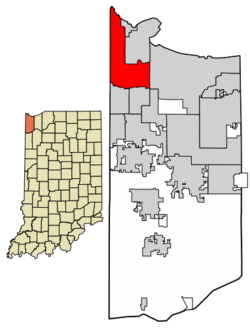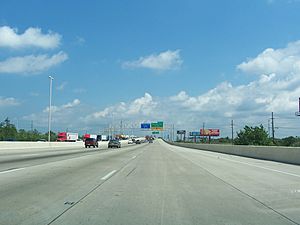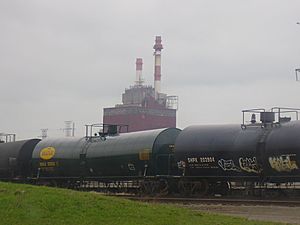Hammond, Indiana facts for kids
Quick facts for kids
Hammond, Indiana
|
|||
|---|---|---|---|

Downtown Hammond
|
|||
|
|||

Location of Hammond in Lake County, Indiana
|
|||
| Country | United States | ||
| State | Indiana | ||
| County | Lake | ||
| Township | North | ||
| Settled | 1847 | ||
| Founded | 1869 | ||
| Incorporated (town) | December 4, 1883 | ||
| Incorporated (city) | April 21, 1907 | ||
| Named for | George H. Hammond | ||
| Government | |||
| • Type | Mayor–council | ||
| Area | |||
| • City | 23.827 sq mi (61.712 km2) | ||
| • Land | 22.741 sq mi (58.898 km2) | ||
| • Water | 1.086 sq mi (2.812 km2) | ||
| Elevation | 584 ft (178 m) | ||
| Population
(2020)
|
|||
| • City | 77,879 | ||
| • Estimate
(2023)
|
76,193 | ||
| • Rank | IN: 8th | ||
| • Density | 3,350/sq mi (1,294/km2) | ||
| • Urban | 8,671,746 (US: 3rd) | ||
| • Metro | 9,262,825 (US: 14th) | ||
| Standard of living (2018–22) | |||
| • Per capita income | $26,109 | ||
| • Median home value | $129,100 | ||
| Time zone | UTC−6 (Central (CST)) | ||
| • Summer (DST) | UTC−5 (CDT) | ||
| ZIP Codes |
46320, 46321, 46322, 46323, 46324, 46325, 46327
|
||
| Area code(s) | 219 | ||
| FIPS code | 18-31000 | ||
| GNIS feature ID | 2394280 | ||
| Sales tax | 7.0% | ||
Hammond is a city in Lake County, Indiana, United States. It's located right next to Lake Michigan and is part of the larger Chicago metropolitan area. Hammond is special because it's the only city in Indiana that shares a border with Chicago.
In 2020, about 77,879 people lived in Hammond, making it the eighth-largest city in Indiana. The city was first settled in the mid-1800s and is one of the oldest cities in northern Lake County. Hammond stretches from Lake Michigan in the north down to the Little Calumet River in the south. It also runs from the Illinois state line in the west to Cline Avenue in the east. Many railroads and highways, like the South Shore Line and Borman Expressway, pass through the city.
Some cool places in Hammond include the parks around Wolf Lake and the Horseshoe Hammond casino. Hammond has always been an industrial city, but it's also home to a campus of Purdue University and many interesting historic areas.
Contents
Discover Hammond, Indiana
A Look at Hammond's Past
The first European settlers arrived in the Hammond area around 1847. They were mostly German farmers looking for new land. Before them, the area was a busy crossroads for Native American tribes and explorers.
Hammond started to become an industrial city in 1869. This happened when the George H. Hammond Company opened a meat-packing plant. The city was officially formed on April 21, 1884. It was named after George H. Hammond, a butcher from Detroit.
Hammond is one of the oldest cities in Lake County. Only Crown Point is older, started in 1834. George Henry Hammond was a pioneer in using refrigerated railcars. These cars helped transport fresh meat without it spoiling. He built a large meat-packing plant in northern Indiana in the early 1870s. By 1875, his company was selling almost $2 million worth of meat each year!
In the mid-1880s, Hammond's company was processing over 100,000 cattle annually. They also owned 800 refrigerated cars. After George Hammond passed away in 1886, his company became less important. It was later bought by larger meatpackers from Chicago.
Trolley service, run by the Hammond Whiting & East Chicago Electric Railway Company, operated from 1893 to 1940. A sad train accident, known as the Hammond circus train wreck, happened near the city on June 22, 1918.
Downtown Hammond used to be a big shopping area. It had stores like Sears and J. C. Penney. The largest stores were Goldblatt's and E.C. Minas. The E.C. Minas store was open for 90 years, from 1894 to 1984.
During World War II, the Pullman Standard Car Company built M4 Sherman tanks in Hammond. The Woodmar Mall opened in 1954 in the Woodmar neighborhood. It had a large Carson Pirie Scott and Co. store.
In 1960, Hammond's population reached its highest point with 111,698 residents. Like many industrial cities, Hammond saw its population drop in the 1970s and 1980s. However, Hammond's economy was more varied than nearby cities. It relied on light manufacturing, transportation, retail, banking, and healthcare. In 1981, a barrier was built on 165th Street due to a disagreement with Gary, Indiana.
Today, major manufacturing companies in Hammond include Unilever (soap), Atlas Tube, and Cargill (food processing). There are also large oil storage facilities and railroad yards. The Indiana Harbor Belt Railroad has its main office here. The Empress Casino opened in 1996 and was replaced by the Horseshoe Hammond casino in 2001.
In 2006, it was decided to tear down most of the Woodmar Mall. Plans were made in 2016 for a $12 million sports complex on the old mall site. The Carson's store, the last part of the mall, closed and was torn down in 2019.
Where is Hammond?
Hammond is located on land that was once part of an ancient lake called Lake Chicago. Much of the city's land used to be sand dunes and wet areas. Most of the city has sandy soil with a top layer of black dirt.
The city covers about 23.8 square miles (61.7 square kilometers). About 22.7 square miles (58.9 square kilometers) is land, and 1.08 square miles (2.8 square kilometers) is water.
Hammond's Neighborhoods
- Lakefront
- Marina District
- Five Points
- Robertsdale
- Water Gardens
- North Hammond
- Pulaski Park
- Downtown Hammond
- Central Hammond
- South Hammond
- Woodmar
- Schleicher
- Hessville
Lakes and Rivers
- Grand Calumet River (part of it)
- Lake George
- Lake Michigan (part of it)
- Little Calumet River (part of it)
- Oxbow Lake
- Wolf Lake (part of it)
Neighboring Cities and Towns
- In Illinois:
- In Indiana:
People of Hammond
| Historical population | |||
|---|---|---|---|
| Census | Pop. | %± | |
| 1880 | 699 | — | |
| 1890 | 5,284 | 655.9% | |
| 1900 | 12,376 | 134.2% | |
| 1910 | 20,925 | 69.1% | |
| 1920 | 36,004 | 72.1% | |
| 1930 | 65,559 | 82.1% | |
| 1940 | 70,183 | 7.1% | |
| 1950 | 87,595 | 24.8% | |
| 1960 | 111,698 | 27.5% | |
| 1970 | 107,983 | −3.3% | |
| 1980 | 91,985 | −14.8% | |
| 1990 | 84,236 | −8.4% | |
| 2000 | 83,048 | −1.4% | |
| 2010 | 80,830 | −2.7% | |
| 2020 | 77,879 | −3.7% | |
| 2023 (est.) | 76,193 | −5.7% | |
| U.S. Decennial Census 2020 Census |
|||
In 2020, Hammond had 77,879 people living in the city. There were 29,486 households. About 23.4% of residents were under 18 years old. About 13.2% were 65 or older.
The city's population is diverse. About 39.2% of people were White, 26.0% were African American, and 40.2% were Hispanic or Latino (who can be of any race).
Hammond's Economy
Hammond has many businesses that provide jobs for its residents. Here are some of the largest employers:
| # | Employer | # of employees |
|---|---|---|
| 1 | Franciscan Health Hammond | 2,500 |
| 2 | School City of Hammond | 2,485 |
| 3 | Horseshoe Casino | 1,866 |
| 4 | City of Hammond | 875 |
| 5 | Walmart | 785 |
| 6 | Indiana Harbor Belt Railroad | 759 |
| 7 | Lear Seating Corporation | 615 |
| 8 | Contract Services Group | 300 |
| 9 | Unilever | 255 |
| 10 | Morrison Construction Company | 250 |
| 11 | Cargill | 240 |
Arts, Culture, and History
Hammond has several places listed on the National Register of Historic Places. These are important buildings and areas that show the city's history.
Historic Places to See
- Morse Dell Plain House and Garden
- Forest-Ivanhoe Residential Historic District
- Forest-Moraine Residential Historic District
- Forest-Southview Residential Historic District
- Glendale Park Historic District
- Hohman Avenue Commercial Historic District
- Indi-Illi Park Historic District
- Northern States Life Insurance Company
- Pullman-Standard Historic District
- Roselawn-Forest Heights Historic District
- Southmoor Apartment Hotel
- State Bank of Hammond Building
- State Street Commercial Historic District
- George John Wolf House
Public Libraries
The Hammond Public Library is located at 564 State Street. It has a special room called the Suzanne G. Long Local History Room. This room is great for learning about the city's past.
Sports in Hammond
Hammond has a history with sports, especially baseball and basketball.
Famous Sports Teams
- In 1972, the Hammond Little League team played in the 1972 Little League World Series. They were defeated by the team from Taipei, Taiwan.
- The Hammond Rollers was a basketball team founded in 2006.
- The Hammond Ciesar All-Americans (1938–41) and Hammond Calumet Buccaneers (1948–49) were professional basketball teams. Famous players like Lou Boudreau and John Wooden played for the Ciesar All-Americans.
The Hammond Pros Football Team
The Hammond Pros was one of the very first professional football teams in the United States. They were a founding member of the American Professional Football League in 1920. This league later became the National Football League (NFL) in 1922.
During their four years, the Hammond Pros had six of the NFL's first nine African-American players. The NFL's first African-American head coach, Fritz Pollard, coached the Pros. Interestingly, the Hammond Pros never played a home game in Hammond itself.
Schools and Learning
All schools in Hammond are part of the School City of Hammond. This is a school district that operates independently from the city government.
In June 2021, two junior/senior high schools, Donald E. Gavit and George Rogers Clark, were permanently closed.
High Schools
- Area Career Center
- Hammond High School
- Morton High School
- George Rogers Clark High School (Closed 2021)
- Gavit High School (Closed 2021)
Middle Schools
- George Rogers Clark Middle School (Closed 2021)
- Henry W. Eggers Middle School
- Gavit Middle School (Closed 2021)
- Scott Middle School
Elementary Schools
- Columbia Elementary School
- Edison Elementary School
- Benjamin Franklin Elementary School
- Warren G. Harding Elementary School
- Joseph Hess Elementary School
- Washington Irving Elementary School
- Thomas Jefferson Elementary School
- Kenwood Elementary School
- Lafayette Elementary School
- Lincoln Elementary School
- Maywood Elementary School
- Morton Elementary School
- Frank O'Bannon Elementary School
- Lew Wallace Elementary School
Charter Schools
- Hammond Academy of Science and Technology (for grades 6–12)
Private Schools
- Bishop Noll Institute (high school)
- City Baptist High School
- Hazel Young Academy
- Montessori Children's Schoolhouse
- St. Casimir (elementary school)
- St. John Bosco (elementary school)
- St. John the Baptist (elementary school)
Catholic schools in Hammond are managed by the Roman Catholic Diocese of Gary. St. Catherine of Siena, a Catholic elementary school, closed in 2009.
Colleges and Universities
- Calumet College of St. Joseph
- Kaplan University
- Purdue University Northwest
Getting Around Hammond
Most of Hammond's streets are set up in a grid, similar to Chicago's streets. The state line helps with numbering east-west streets.
Major Highways
- I-90 – Indiana Toll Road, with exits at:
- Indianapolis Boulevard – U.S. 12/20/41
- Calumet Avenue – U.S. 41
- Cline Avenue – State Road 912
- I-80/94 – Borman Expressway, with exits at:
- Calumet Avenue – U.S. 41 North
- Indianapolis Boulevard – U.S. 41 South/State Road 152
- Kennedy Avenue
- Cline Avenue – State Road 912
Public Transportation
The South Shore Line is a commuter train that runs from Chicago to South Bend, Indiana. It has a station on Hohman Avenue in Hammond.
Amtrak, the national passenger train system, offers daily service. Its Wolverine train stops at the Hammond–Whiting station. This train travels between Chicago and Pontiac, Michigan.
The closest commercial airport is Chicago Midway International Airport, about 25 miles away in Chicago.
Bus services were once provided by the Hammond Transit System. These services were stopped in 2012 due to a lack of money. However, some Pace and GPTC bus routes still stop at Hammond's Dan Rabin Transit Plaza.
Healthcare and Utilities
Hammond used to have a hospital called Franciscan St. Margaret Health. It was located on Stateline Road. The hospital closed in December 2022.
Utilities
- Electricity and Natural Gas: Most of Hammond's electricity and natural gas comes from NIPSCO.
- Water: The Hammond Water Department provides water service to most people in the city. It is a state-owned utility run by the city government.
Famous People from Hammond
Sister City
- Galați, Romania (since 1997)
See also
 In Spanish: Hammond (Indiana) para niños
In Spanish: Hammond (Indiana) para niños






